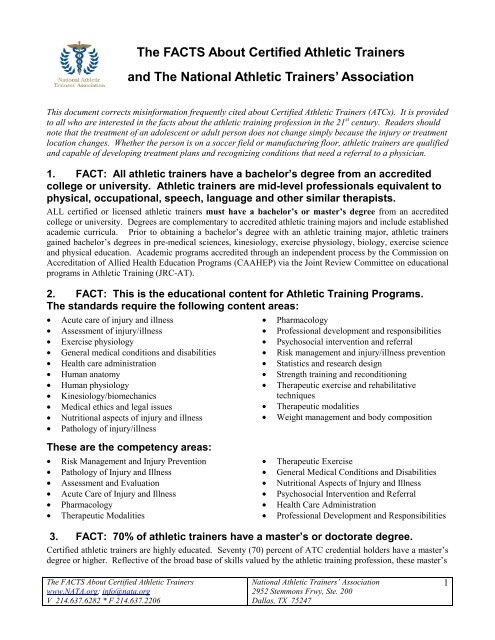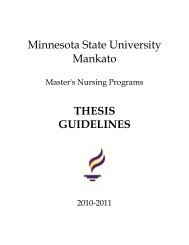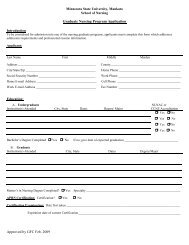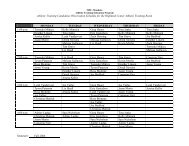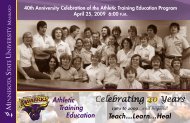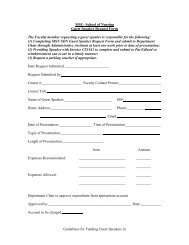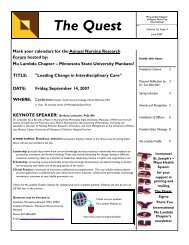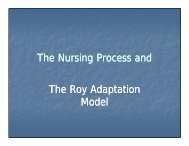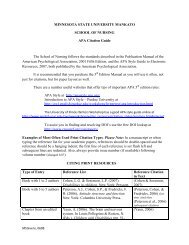The FACTS About Certified Athletic Trainers - Nevada Athletic ...
The FACTS About Certified Athletic Trainers - Nevada Athletic ...
The FACTS About Certified Athletic Trainers - Nevada Athletic ...
You also want an ePaper? Increase the reach of your titles
YUMPU automatically turns print PDFs into web optimized ePapers that Google loves.
degrees may be in athletic training (clinical), education, exercise physiology, counseling or health careadministration or promotion. This great majority of practitioners who hold advance degrees is comparable toother allied health care professionals, including physical therapists, occupational therapists, registered nurses,speech therapists and many other mid-level health care practitioners.4. FACT: <strong>Athletic</strong> trainers know and practice the medical arts at the highestprofessional standards.<strong>Athletic</strong> trainers meet the qualifications and standards of any group—including Medicare and Medicaid—necessary to render skilled services and gain reimbursement for services rendered. <strong>Athletic</strong> trainers specialize ininjury and illness prevention, assessment, treatment and rehabilitation for all physically active people, includingthe general public.5. FACT: <strong>Athletic</strong> trainers are regulated and licensed health care workers.While practice act oversight varies by state, the athletic trainer practices under state statute recognizing them asa health care professional similar to physical therapists, occupational therapists and similar mid-levelprofessionals. <strong>Athletic</strong> training licensure/regulation exists in 43 states, with aggressive efforts underway topursue licensure in the remaining states. <strong>Athletic</strong> trainers practice under the direction of physicians.6. FACT: An independent national board certifies athletic trainers.<strong>The</strong> independent Board of Certification Inc. (BOC) nationally certifies athletic trainers. <strong>Athletic</strong> trainers mustpass an examination and hold a bachelor’s degree to become an <strong>Athletic</strong> Trainer, <strong>Certified</strong> (ATC). To retaincertification, ATC credential holders must obtain 80 hours of medically related continuing education creditsevery three years and adhere to a code of ethics. <strong>The</strong> BOC is accredited by the National Commission forCertifying Agencies.7. FACT: <strong>Athletic</strong> trainers are recognized allied health care professionals.ATCs are highly qualified, multi-skilled allied health care professionals, and have been part of the AmericanMedical Association’s Health Professions Career and Education Directory for more than a decade.Additionally, the American Academy of Family Physicians, American Academy of Pediatrics and AmericanOrthopaedic Society for Sports Medicine are all strong clinical and academic supporters of athletic trainers.8. FACT: 40 percent of NATA’s certified athletic trainer members workoutside of school athletic settings, and provide services to physically activepeople of all ages.<strong>Certified</strong> athletic trainers work in physician offices as physician extenders. <strong>The</strong>y also work in rural and urbanhospitals, hospital emergency rooms, urgent and ambulatory care centers, military hospitals, physical therapyclinics, high schools, colleges/universities, commercial employers, professional sports teams and performancearts companies. <strong>The</strong>y are multi-skilled health care workers who, like others in the medical community withscience-based degrees, are in great demand because of the continuing and increasing shortage of registerednurses and other health care workers. <strong>The</strong> skills of ATCs have been sought and valued by sports medicinespecialists and other physicians for more than 50 years. As the U.S. begins its fight against the obesityepidemic, it is important that people have access to health care professionals who can support lifelong physicalactivity for all ages.9. FACT: <strong>Athletic</strong> trainers have designated CPT/UB Codes.<strong>The</strong> American Medical Association (AMA) granted Current Procedural Terminology (CPT) codes for athletictraining evaluation and re-evaluation (97005, 97006) in 2000. <strong>The</strong> codes became effective in 2002. In addition,the American Hospital Association established Uniform Billing (UB) codes—or revenue codes—for athletictraining in 1999, effective 2000.<strong>The</strong> <strong>FACTS</strong> <strong>About</strong> <strong>Certified</strong> <strong>Athletic</strong> <strong>Trainers</strong>www.NATA.org; info@nata.orgV 214.637.6282 * F 214.637.2206National <strong>Athletic</strong> <strong>Trainers</strong>’ Association2952 Stemmons Frwy, Ste. 200Dallas, TX 752472
10. FACT: CPT and UB codes are not provider specific.<strong>The</strong> AMA states that the term “provider,” as found in the Physical Medicine section of the CPT code, is ageneral term used to define the individual performing the service described by the code. According to theAMA, the term therapist is not intended to denote any specific practice or specialty field. Physical therapistsand/or any other type of therapists are not the exclusive providers of general physical medicine examinations,evaluations and interventions. Similar to the athletic training evaluation and re-evaluation codes, othertherapists have their own specific evaluation codes.11. FACT: ATCs improve patient functional and physical outcomes.Results from a nationwide Medical Outcomes Survey conducted 1996-1998 demonstrate that care provided byATCs effects a significant change in all outcomes variables measured, with the greatest change in functionaloutcomes and physical outcomes. <strong>The</strong> investigation indicates that care provided by ATCs generates a change inhealth-related quality of life patient outcomes. (ref: Albohm MJ, Wilkerson GB. An outcomes assessment ofcare provided by certified athletic trainers. J Rehabil. Outcomes Meas. 1999; 3(3):51-56.)12. FACT: ATCs frequently work in rural, frontier and medically underservedareas and with physically active people of all ages.ATCs are accustomed to working in urgent care environments that have challenging, sometimes-adverse workand environmental conditions. <strong>The</strong> athletic training tradition and hands-on clinical and academic educationcombine to create a health care professional who is flexible and inventive—ideal managers of patient care andhealth care delivery. ATCs are generally a replacement—not an addition—to other types of physical medicinetherapies performed. ATCs are an “or” not an “and” and therefore costs for providing therapy are notincreased with the use of athletic training services.13. FACT: ATCs specialize in patient education to prevent injury and re-injuryand reduce rehabilitative and other health care costs.Recent studies, reports, outcomes measures surveys, total joint replacement studies and many other case studiesdemonstrate how the services of ATCs save money for the employers and improve quality of life for the patient.For each $1 invested in preventive care, employers gained up to a $7 return on investment, according to oneNATA survey. <strong>The</strong> use of certified athletic trainers supports a market-driven health care economy that increasescompetition in order to reduce patient and disease costs. Through the use of proper rehabilitation and evaluation,athletic trainers prevent re-injury. <strong>The</strong> patient’s standard of care is enhanced with ATCs, not sacrificed.14. FACT: ATCs provide the same or better outcomes in clinical settings asother providers, including physical therapists.Results of a comparative analysis of care provided by certified athletic trainers and physical therapists in aclinical setting indicated that ATCs provide the same levels of outcomes, value and patient satisfaction asphysical therapists in a clinical setting. (ref: Reimbursement of <strong>Athletic</strong> Training by Albohm, MJ; Campbell, Konin, pp.25)Patient satisfaction ratings are more than 96 percent when treatment is provided by ATCs.15. FACT: <strong>The</strong> National <strong>Athletic</strong> <strong>Trainers</strong>’ Association represents 30,000members.<strong>The</strong> National <strong>Athletic</strong> <strong>Trainers</strong>’ Association (NATA), founded in 1950, represents more than 30,000 membersof the international profession. Of the total membership, 24,000 are ATCs, which represents more than 90percent of all athletic trainers practicing in the United States. Annual membership retention averages 92percent. NATA accurately claims the distinction of representing the great majority of the athletic trainingprofessionals.May04<strong>The</strong> <strong>FACTS</strong> <strong>About</strong> <strong>Certified</strong> <strong>Athletic</strong> <strong>Trainers</strong>www.NATA.org; info@nata.orgV 214.637.6282 * F 214.637.2206National <strong>Athletic</strong> <strong>Trainers</strong>’ Association2952 Stemmons Frwy, Ste. 200Dallas, TX 752473


